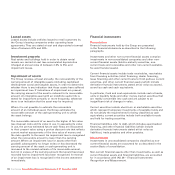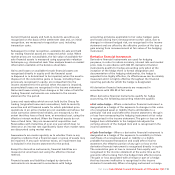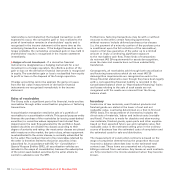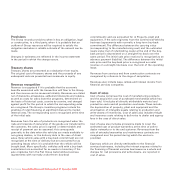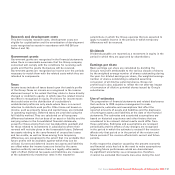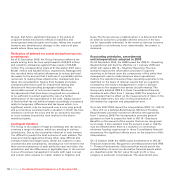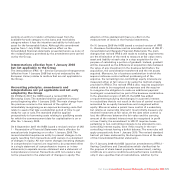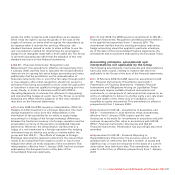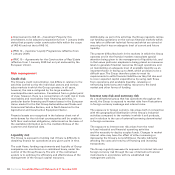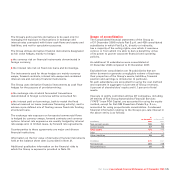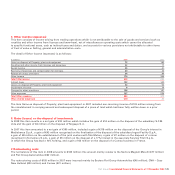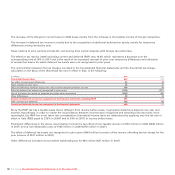Chrysler 2008 Annual Report Download - page 123
Download and view the complete annual report
Please find page 123 of the 2008 Chrysler annual report below. You can navigate through the pages in the report by either clicking on the pages listed below, or by using the keyword search tool below to find specific information within the annual report.Fiat Group Consolidated Financial Statements at 31 December 2008122
entity or by other parties, should receive the same accounting
treatment. The Group will apply this amendment
retrospectively from 1 January 2009; no significant effects are
expected to arise on its adoption.
On 22 May 2008 the IASB issued a series of amendments to
IFRS (“Improvements”). Details are provided in the following
paragraphs of those identified by the IASB as resulting in
accounting changes for presentation, recognition and
measurement purposes, leaving out amendments regarding
changes in terminology or editorial changes which are likely
to have minimal effects on accounting and improvements that
relates to matters not applicable to the Group.
IFRS 5 –
Non-Current Assets Held for Sale and Discontinued
Operations
: this amendment, to be applied prospectively from
1 January 2010, requires an entity that is committed to a sale
plan involving loss of control of a subsidiary to classify all the
assets and liability of that subsidiary as held for sale,
regardless of whether the entity will retain a non-controlling
interest in its former subsidiary after the sale.
IAS 1 –
Presentation of Financial Statements (revised in
2007)
: this amendment, to be applied prospectively from
1 January 2009, requires an entity to classify assets and
liabilities arising from derivative financial instruments that are
not classified as held for trading between current and non-
current assets and liabilities. The adoption of this standard will
have no effect on the measurement of items in the financial
statements.
IAS 16 –
Property, Plant and Equipment
: this amendment,
effective retrospectively from 1 January 2009, requires an
entity that in the course of its ordinary activities routinely sells
items of property, plant and equipment that it has held for
rental to others, to transfer such assets to inventories when
they cease to be rented and become held for sale. As a
consequence, the proceeds from the sale of such assets shall
be recognised as revenue. Cash payments to manufacture or
acquire assets held for rental to others or subsequently held
for sale are cash flows from operating activities (and not from
investing activities). The adoption of this standard will have no
effect on the measurement of items in the financial statements.
IAS 19 –
Employee Benefits
: this amendment, effective
prospectively from 1 January 2009 to changes in benefits that
occur after that date, clarifies the definition of positive/negative
past service costs and states that in the case of a curtailment,
only the effect of the reduction for future service shall be
recognised immediately in the income statement, while the
effect arising from past service periods shall be considered
a negative past service cost. The Board also revised the
definition of short-term employee benefits and other long-term
employee benefits and the definition of a return on plan assets,
stating that this amount should be net of any costs for
administering the plan (other than those included in the
measurement of the defined benefit obligation).
IAS 20 –
Government Grants and Disclosure of Government
Assistance
: this amendment, applicable prospectively from
1 January 2009, states that the benefit of a government loan at a
below-market rate of interest shall be treated as a government
grant and then accounted for in accordance with IAS 20.
IAS 23 –
Borrowing Costs
: this amendment, applicable from
1 January 2009, revises the definition of borrowing costs.
IAS 28 –
Investments in Associates
: this amendment shall be
applied from 1 January 2009, with prospective application also
permitted, requires that for investments accounted for using
the equity method a recognised impairment loss should not be
allocated to any asset (and in particular goodwill) that forms
part of the carrying amount of the investment in the associate,
but to the carrying amount of the investment overall. Accordingly
any reversal of that impairment loss is recognised in full.
IAS 36 –
Impairment of Assets
: this amendment, effective
from 1 January 2009, requires additional disclosures to be
made in the case in which an entity determines the recoverable
amount of a cash-generating unit using discounted cash flows.
IAS 38 –
Intangible Assets
: this amendment, effective
retrospectively from 1 January 2009, requires expenditure on
advertising and promotional activities to be recognised in the
income statement. Further, it states that in the case expenditure
is incurred to provide future economic benefits to an entity, but
no intangible assets is recognised, in the case of the supply of


